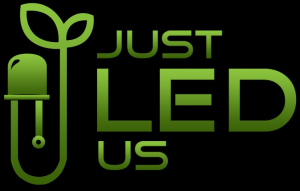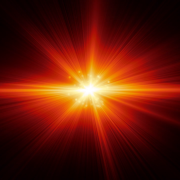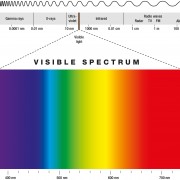Keeping Your LED Light at a Proper Distance

Indoor Garden Plant Growth
Keeping the proper distance between your full spectrum LED grow light and your plants is important for photosynthesis and growth. Full Spectrum LED grow lights provide the wavelengths of light your plants need for germinating, growth/vegetation and flowering/fruiting. You should always monitor the distance between the top of the garden canopy and the light source as the light becomes more intense when the garden grows. Increasing the height of the LED grow light will allow for a constant delivery of intensity to the gardening area.
If you place you LED grow light too close to your plants they will not dry out or burn, unless they are physically touching the lens or chip. In most cases your plantation will be stunted if the light is hanging close, so really it is not a good idea to place the lights too close. We suggest placing your lights in the general range of 0.3 metres (30 cm) ~ 1.5 metres (150 cm).
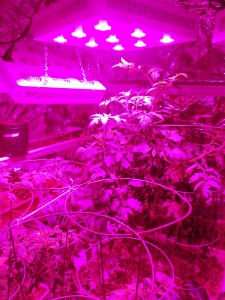
Indoor Garden Plant Growth
When your garden is in the vegetative stage maintain the above noted distances. The intensity from your Grow light will diminish by travelling a greater distance. This will allow for plant stretching as it will also spread out over a greater area. To grow shorter, bushier plants decreases the distance. As you raise the light, the plants will reach for the source and grow taller, but it is important to note that raising the light source too high will cause excessive stretching. Simply put, your inter-nodal spacing will be a great indicator as to the placement of the light. Some grow lights promote tight inter-nodal spacing and in some cases this isn’t always what you want for your plantation as some of the energy that is being used in photosynthesis may very well be used for other areas of plant development. LED grow lights radiate energy (Photosynthetically Active Radiation-PAR) in a constant forward facing fashion and take only fractions of a second to reach your canopy. The intensity of light from a point source (energy per unit of area perpendicular to the source) is inversely proportional to the square of the distance from the source so an object twice as far away, receives only 1⁄4 the energy (in the same time period).
Generally, if you keep the light at an affixed height, the plants will reach a certain growth point, then grow wider and form more vegetation. Although this is also a fact in nature when growing under the sun, we must consider that the orbit of Earth ranges from 1.47 to 1.52 x 1011 meters from the Sun and that the average travel time of light to the earth is 8.3 minutes. The Sun has a range of electromagnetic energy that is emitted known as the solar spectrum and lies mainly in three regions: ultraviolet,visible, and infrared.
The solar spectrum extends from about 0.29 µm (or 290 nm) in the longer wavelengths of the ultraviolet region, to over 3.2 µm (3,200 nm) in the far infrared. The spectral levels noted above are large and vast and even they have environmental variables when it comes to atmosphere, clouds, buildings and trees, etc.
Electromagnetic radiation from the sun comes to Earth in the form of radiation. The term “radiation” simply denotes the fact that the energy travels as rays, that is, in straight lines. Similarly, (PAR) photosynthetic radiation also travels in a linear fashion but it is a mere few feet away from the canopy and doesn’t have an atmosphere to compensate for naturally occurring variables. Therefore, you will want to adjust the height of your grow light occasionally, accordingly based on the height of your plantation or garden.
The sun radiates energy equally in all directions and the Earth intercepts and receives part of this energy. The power flux reaching the top of the Earth’s atmosphere is about 1400 Watts/m2. This measure simply means that on average, one square meter on the side of the Earth facing the sun receives energy from the sun equal to that from fourteen 100 Watt light bulbs every second!
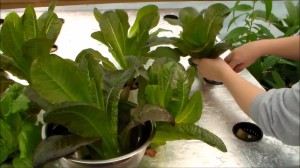
Hydroponic Lettuce Growth
Commonly, LED grow lights also are measured in the visible light spectrum such as ultraviolet, visible, and infrared, PAR regions (400–740nm) but the source is a constant excluding the height at which the light is fixed above the canopy and the amount of time which you have your LED light on – daily light interval (DLI).
Generally speaking, most plant growth and morphology is commonly the same, plants grow up and outward. Plants will stretch upwards when the light source is at a constantly and kept at or above the suggested distance from the canopy and they will start to bush out and grow more dense if the light source is not changed. If your light is placed in a fixed position the plants will grow to a certain point and then they will grow in width but as noted above with some plant species adjustments will have to be made so that the canopy doesn’t touch the actual LEDs. Certain plants require different PAR ranges. This directly relates to what you want to grow and correlates to the intensity of light which is available accordingly to certain models will cast a different canopy area. The growing area you have available is important in relation to this topic. When it comes down to it, the units all cast a different PAR value and coverage Area (m²) is based on their size and wattage. Smaller units will cover less area and will have to be placed closer where the larger units will cover more area and (in some cases) you will have the ability to place the light source farther away from the canopy or growing surface – hence having a bigger garden.
For flowering plants, the lights can be left at the affixed height and the daily light interval must change.
Important! Plant species vary, thus, they all have a variety of specific lighting needs. PAR value, umol’s (moles per square meter per second) or daily light interval are three valuable things one needs to look at when evaluating a large gardening area. Some gardeners have different methods to quantify their personal needs so we have included a few approaches here on our site!
Most different plant varieties take advantage of ‘full spectrum light’ when it is used throughout the vegetative and flowering cycles, and we must note that LEDs penetrate your plantation differently than older lighting technologies such as high pressure sodium and metal halide, thus, the usage of light differs as well.
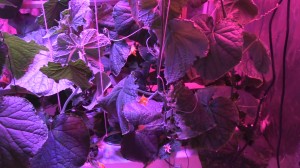
Cucumber Flowering
If you are keeping your LED light at a proper distance you will have stronger plants and a consistent growth pattern when using full spectrum lighting. You will further find that internodal spacing is shorter while the stems stay stronger and are less prone to breaking as the plant expends less energy growing stems, and more energy producing flowers or fruits.
If you are a researcher, you may be interested in ordering a specific singular spectrum or a specific spectrum ratio built to supplement your existing lighting system. Ex. Some light spectra build, stimulate root development and some stimulate flowering and fruiting.
There are clients who like to conduct research with a certain spectra of supplementary lighting and we understand that it is important to give our customers these options as customizations. Supplemental lighting with LED lights can increase the light intensity a crop receives and improves and accelerates its growth and development. If you choose to use supplemental LED lighting for an existing in home garden, slowly introduce it for short intervals as you will find that your plants may experience a shock when the additional light is present because of the introduction to a blast of additional spectrum and intensity. This happens because they have to prepare themselves for the new amount of light they are receiving, otherwise known as light saturation point.
Some people believe in older methodologies which pertain to the usage of light changes when (HPS & MH) are used so if you are adaptive to this system of analogy to maximize your yield we suggest chatting with us. For example you can choose to opt to order the chips to be customized according to what your needs are (Red 660 or 680nm, Infra-red 740nm, and UV) if you so choose.
The most efficient LED grow lights should have spectra specifically balanced LEDs for growing. This is generally achieved by using a mix of red and blue then white, ambers and far-red ranges so that they cover the entire spectrum. Generally, full spectrum light varies from one manufacturer to another. The wavelengths will vary based on the type of LEDs and the amount of LEDs arranged in certain ratio of spectra. We realise that everyone will have different gardens and thus we further understand your specialised gardening needs for different plant families throughout their stages of life.
